Most Common Extrusive Igneous Rock
Habitation » Rocks » Igneous Rocks
Pictures of Igneous Rocks
Photos and Descriptions of Common Intrusive and Extrusive Igneous Rock Types
Commodity by: , PhD, RPG
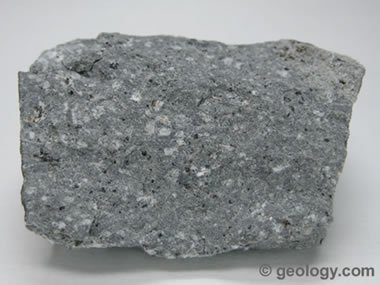
Andesite is a fine-grained, extrusive igneous rock composed mainly of plagioclase with other minerals such as hornblende, pyroxene, and biotite. The specimen shown is about 2 inches (5 centimeters) across.
What are Igneous Rocks?
Igneous rocks are formed from the solidification of molten rock material. Some class below World'due south surface. Some course on or higher up Earth's surface. We describe these 2 basic types:
Intrusive igneous rocks crystallize below Globe's surface, and the slow cooling that occurs there allows large crystals to form. Examples of intrusive igneous rocks are: diabase, diorite, gabbro, granite, pegmatite, and peridotite.
Extrusive igneous rocks erupt onto the surface, where they cool quickly to grade pocket-size crystals. Some absurd and so quickly that they course an baggy glass. These rocks include: andesite, basalt, dacite, obsidian, pumice, rhyolite, scoria, and tuff.
Pictures and brief descriptions of some mutual igneous rock types are shown on this page.
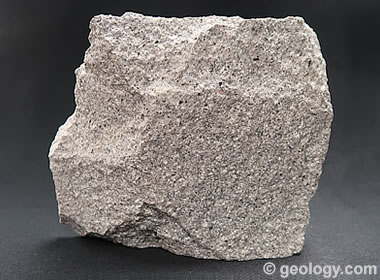
Dacite is a fine-grained, extrusive igneous rock that is usually light in color. It has a composition that is intermediate between rhyolite and andesite. The specimen shown is about iv inches (ten centimeters) across.
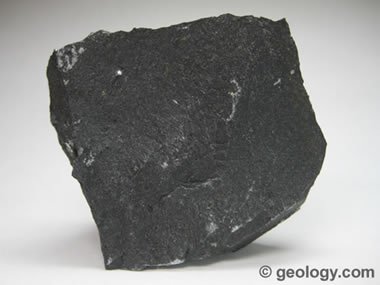
Basalt is a fine-grained, dark-colored extrusive igneous stone composed mainly of plagioclase and pyroxene. The specimen shown is nearly two inches (five centimeters) across.
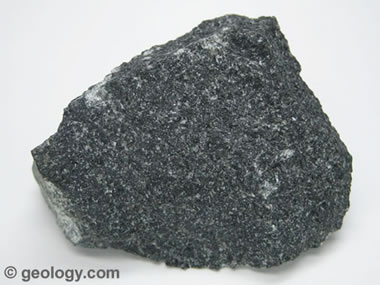
Diabase is an intrusive igneous rock composed mostly of plagioclase feldspar and pyroxene minerals. The grains in diabase are larger than those in basalt but smaller than those in gabbro. Diabase is used in the construction manufacture as trap rock or dimension stone. When the diabase contains colorful labradorite crystals, it makes an particularly overnice architectural rock.
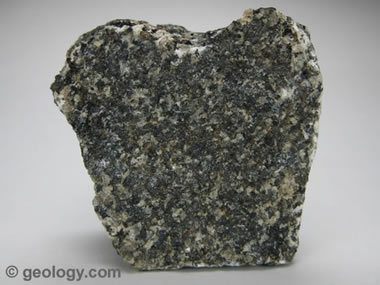
Gabbro is a fibroid-grained, night-colored, intrusive igneous rock that contains feldspar, pyroxene, and sometimes olivine. The specimen shown above is near two inches (five centimeters) across.
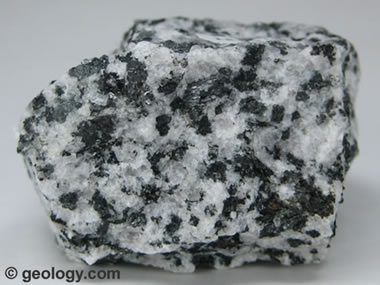
Diorite is a coarse-grained, intrusive igneous rock that contains a mixture of feldspar, pyroxene, hornblende, and sometimes quartz. The specimen shown to a higher place is about ii inches (5 centimeters) across.

Obsidian is a dark-colored volcanic glass that forms from the very rapid cooling of molten rock cloth. Information technology cools so chop-chop that crystals do not course. The specimen shown above is most two inches (five centimeters) across.
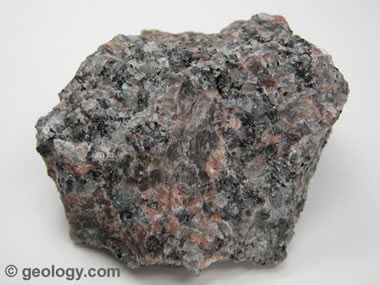
Granite is a coarse-grained, light-colored, intrusive igneous rock that contains mainly quartz, feldspar, and mica minerals. The specimen to a higher place is about two inches (v centimeters) beyond.
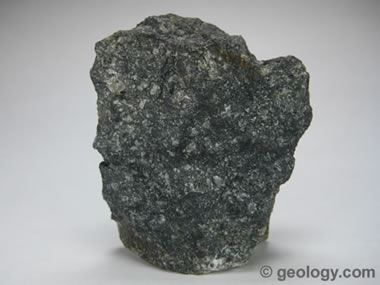
Peridotite is a coarse-grained intrusive igneous stone that is composed virtually entirely of olivine. It may incorporate small amounts of amphibole, feldspar, quartz, or pyroxene. The specimen shown higher up is well-nigh ii inches (five centimeters) across.
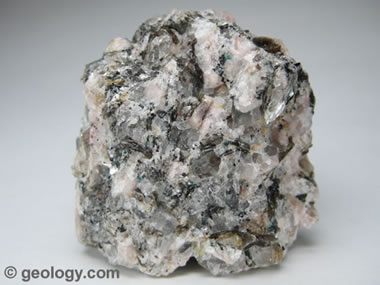
Pegmatite is a lite-colored, extremely coarse-grained intrusive igneous stone. Information technology forms near the margins of a magma bedchamber during the terminal phases of magma bedroom crystallization. It often contains rare minerals that are not found in other parts of the magma chamber. The specimen shown above is about ii inches (five centimeters) across.
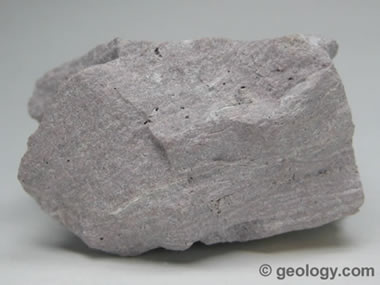
Rhyolite is a light-colored, fine-grained, extrusive igneous rock that typically contains quartz and feldspar minerals. The specimen shown above is about two inches (v centimeters) beyond.

Pumice is a light-colored vesicular igneous stone. It forms through very rapid solidification of a melt. The vesicular texture is a upshot of gas trapped in the melt at the time of solidification. The specimen shown higher up is about 2 inches (5 centimeters) across.
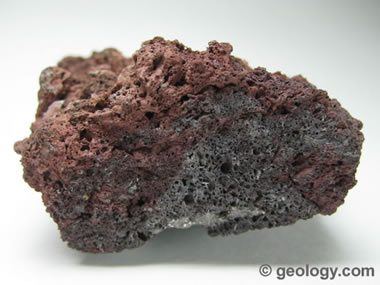
Scoria is a dark-colored, vesicular, extrusive igneous stone. The vesicles are a result of trapped gas within the melt at the time of solidification. Information technology ofttimes forms equally a frothy chaff on the top of a lava catamenia or equally material ejected from a volcanic vent and solidifying while airborne. The specimen shown above is about two inches (five centimeters) across.
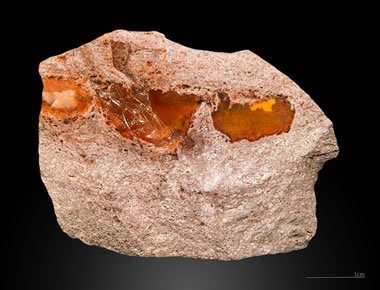
Fire Opal is sometimes found filling cavities in rhyolite. Long after the rhyolite has cooled, silica-rich basis h2o moves through the rock, sometimes depositing gems like opal, red beryl, topaz, jasper, or agate in the cavities of the stone. This is one of many first-class geological photographs generously shared through a Creative Commons License past Didier Descouens.
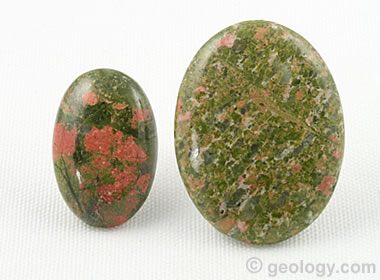
Unakite is a colorful rock composed of greenish epidote and pink orthoclase. It is formed when granite, an igneous rock, is metamorphosed by hydrothermal action. Bonny pieces of unakite are oft used to make cabochons, tumbled stones, minor sculptures, and other lapidary items. It is named after the Unaka Mountains of eastern Tennessee.
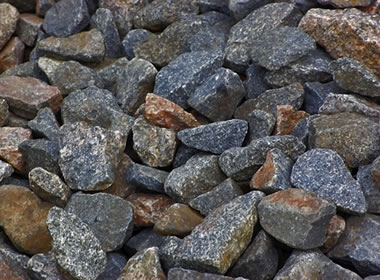
"Trap Rock" is a layman's term for any nighttime-colored igneous rock that is used to make crushed stone. This crushed stone tin be used as road base material, or equally an aggregate in concrete or asphalt. The most common types of trap rock are basalt, diabase, gabbro, and peridotite. Image copyright iStockphoto / Brilt.
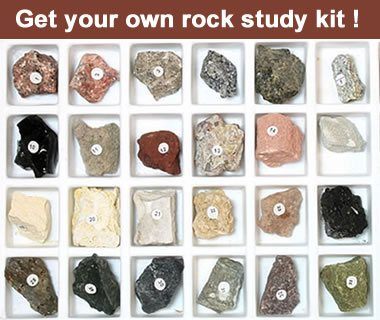
The best way to learn about rocks is to have a collection of specimens to examine while you study. Seeing and handling the rocks volition assist yous understand their composition and texture much better than reading nearly them on a website or in a book. The Geology.com store offers inexpensive rock collections that can be mailed anywhere in the The states or U.S. Territories. Mineral collections and instructive books are too available.
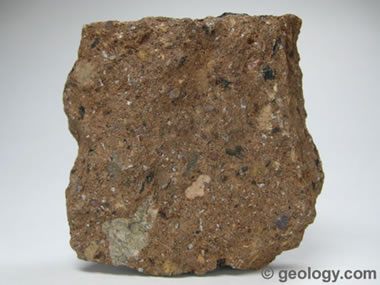
Welded Tuff is a rock that is composed of materials that were ejected from a volcano, roughshod to Earth, and so lithified into a stone. It is commonly composed mainly of volcanic ash and sometimes contains larger size particles such as cinders. The specimen shown above is about two inches (five centimeters) across.
Find Other Topics on Geology.com:
 Rocks: Galleries of igneous, sedimentary and metamorphic rock photos with descriptions. |  Minerals: Data about ore minerals, gem materials and rock-forming minerals. |
 Volcanoes: Manufactures about volcanoes, volcanic hazards and eruptions past and present. |  Gemstones: Colorful images and articles nigh diamonds and colored stones. |
 Full general Geology: Articles about geysers, maars, deltas, rifts, common salt domes, h2o, and much more! |  Geology Shop: Hammers, field numberless, hand lenses, maps, books, hardness picks, gold pans. |
 |  Diamonds: Learn nigh the backdrop of diamond, its many uses, and diamond discoveries. |
Most Common Extrusive Igneous Rock,
Source: https://geology.com/rocks/igneous-rocks.shtml
Posted by: moralesknoid1942.blogspot.com


0 Response to "Most Common Extrusive Igneous Rock"
Post a Comment